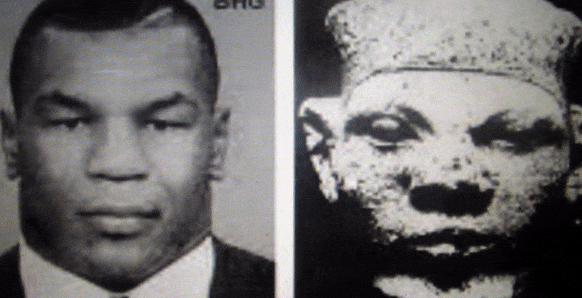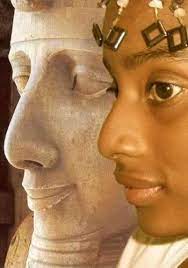Yes!... The mid-upper lip

Winge's Peak (WP)!...
Pharaoh Narmer, who had a WP,
is recorded as the first unifier of
Upper and Lower Egypt when he was 24 years old

and has been said by some to
look like
Boxing Champion Mike Tyson!
Here is Ramesses II

and...
a close resemblant. Ramesses II was
married to
Nefertari. Here's a modern day
A. I. resemblance.
Pharoah Huni's
face was desecrated
so we'll never know for sure if he, like KRS-1, had an elatus
...
...or not.
Pharaoh Akhenaten
(Amenhotep IV) has a
doppelgänger too! His Principle wife was
Nefertiti.
King Tutankhamun
also has
a close double...
King Tut was married to his Great Royal Wife,
Ankhesenamun...

...(an A. I. lookalike?).
Cleopatra, who had several husbands,
is rumored
to have also possessed a
'mystifying'
Winge's Peak
and
is a favored African Ruler!
This 'Most Mysterious'
part of the face
is
'Nature's Mark Of The Blessed,'
and
'God's Sign on his First Powerful Ancient Warriors'
(Originating from the newly-proposed Ancient East African Humanoid Species
approx. 300,000 years ago).
Elatus labialis wingeulus, also known as Winge's Peak, a human,
mid-upper-lip, genetically-dominant physical trait first elucidated
by Los Angeles Dentist Ralph Winge, D.D.S. in 2011, is an
'appendage' over and of the upper lip's middle tubercle frontal
surface, and is a naturally-occurring, variably-manifested,
vertically-oriented, differentiated soft tissue, epithelial-emanating
fold or ridge or line or prominence, or otherwise, with subepithelial
components (Winge's Peak Connective Tissue Complex, which
includes the Hybrid Jaimalah Fibers), which coincides with the midline of
the face and the interincisal and mid-sagittal lines, and runs down the middle
of the middle tubercle surface of the rostral upper lip, which may extend
inferiorly from the middle of the Vermillion Border's Cupid's Bow,
down to the lower edge of the lip, with or without significant elevation
above the surrounding lateral labial tissues, with or without the presence of
differentiated vermillion surface epithelium (Winge Epithelium) seen along
the linear crest of the Peak, with or without a change in hue from the
prevailing local epithelial coloration, and with or without the presence
of an inferiorly-positioned procheilon.
"All humans that have evidence of an elatus labialis wingeulus

on their upper lips

are
considered to have 'Potentiated Functional Capacities to 'be, think and act,''
and are said
to be
direct descendants of the prehistoric humanoid species
homo 
wingeulus."
This very well may be the first time that a prehistoric humanoid species is
being proposed on an interesting soft tissue representation alone.
Additional Resources:
Ralph Winge, D.D.S., USC Dental School Graduate,
and elucidator of

elatus labialis wingeulus.
For all Photos and Gifs seen here, no copyright infringement is intended.






















No comments:
Post a Comment
Your smile's response?